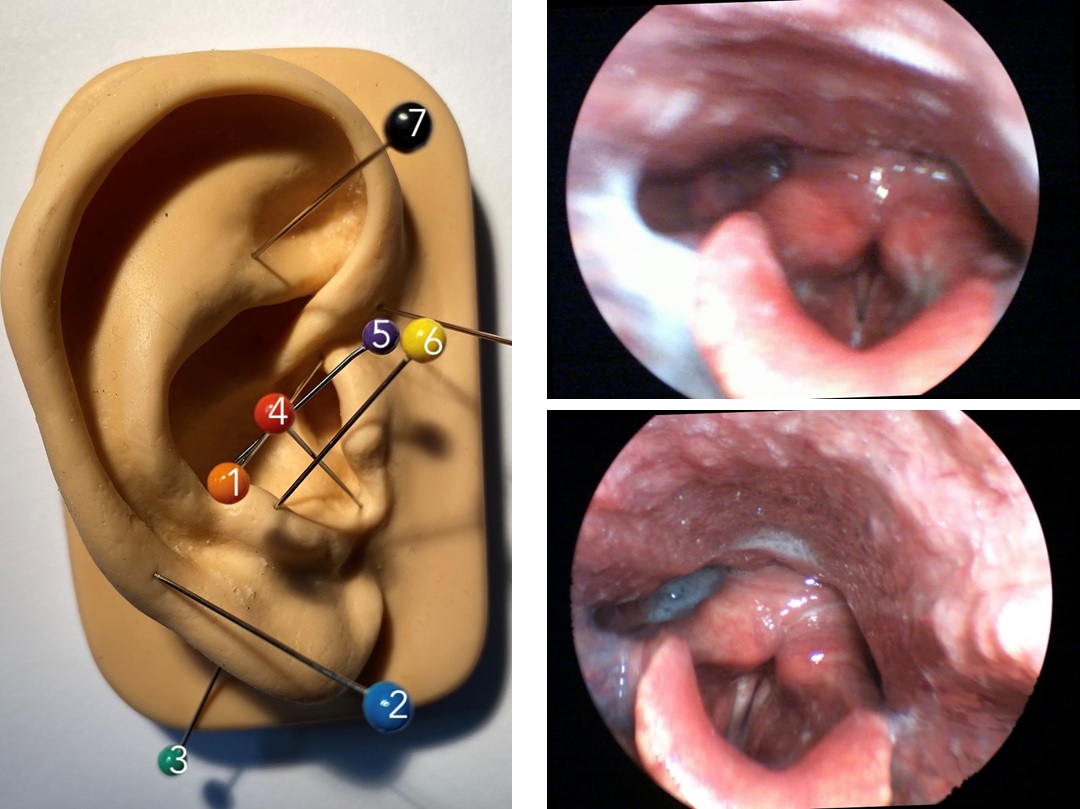Neuroauriculotherapy: Framework and Remarks for a possible use in Voice Medicine
Neuroauriculoterapia: marco y observaciones para un posible uso en medicina de la voz

This work is licensed under a Creative Commons Attribution-NonCommercial-NoDerivatives 4.0 International License.
Show authors biography
Aim. Neuroauriculotherapy (NAT) is a branch of medicine, which, thanks to its diagnostic and therapeutic value, is a powerful tool at the service of both physician and patient. In our experience, as it is discussed in this article, neuroauriculotherapy can have successful applications in voice science and in phoniatrics. The aim of this article is to open a discussion about possible applications of neuroauriculotherapy in voice medicine.
Introduction. From the diagnostic point of view, it is possible to explore, with a palpeur (i.e., a tool that provides a constant pressure) or a “spot-hunter”, the presence of a perturbation into a particular organ or area, and its return to normal during treatment. Indeed, at the level of the ear auricle, representations of an organ, its innervation, its muscular components, etc., are fixed. These spots or voxels correspond absolutely to the respective sensory, motor, visceral, among other spots. Therefore, if any abnormal potential comes from the periphery, it will illuminate the spots both at the cortical level and in the pavilion —a real display with a constantly active touch screen. The spot can be treated with needles in the context of a neurophysiological strategy to send a message to the brain.
Reflection. NAT appears to be a good method to improve the treatment of voice problems, enhancing the results of other therapies based on drugs or rehab and inducing relaxation. In neuroauriculotherapy, the ear is used to give the brain orders in a process which has a logical basis in neurophysiology.
Conclusion. Diseases of the vocal tract can be dysfunctional or organic. According to our clinical experience, we can say that neuroauriculotherapy can be used in both cases. Neuroauriculotherapy is also extremely effective in voice therapy, both alone and in combination with other therapies, as there is no conflict among them.
Article visits 1027 | PDF visits 284
- Stine MD. Electric Field Therapy as an Alternative Medicine in the Clinical Management of Cancer. International Journal of Sciences. 2015;1(11):7.9. doi: http://dx.doi.org/10.18483/ijSci.868 DOI: https://doi.org/10.18483/ijSci.868
- Alimi D. L’auriculothérapie médicale Bases scientifiques, principes et stratégies thérapeutiques. Paris: Elsevier-Masson; 2017. DOI: https://doi.org/10.1016/B978-2-294-75442-5.00035-3
- Nogier PFM. From auriculotherapy to auriculomedicine. Paris: Maisonneuve; 1983.
- Alimi D, Gardeur D, Geissmann A, Bahr F. L’ irm fonctionnelle, clé des cartographies auriculaires. Akupunktur & Aurikulomedizin. 2014 Sep 25;40(3):10-15. doi: http://doi.org/10.1007/s15009-014-5282-z DOI: https://doi.org/10.1007/s15009-014-5282-z
- Alimi D, Geissmann A, Gardeur D. Auricular Acupuncture Stimulation Measured on Functional Magnetic Resonance Imaging. Med Acupunct. 2002 Jan 1;13:18–21.
- Alimi D, Cappello L. Dizionario Enciclopedico di Neuroauricoloterapia. Palermo: Nuova Ipsa Editore; 2014.
- Alimi D, Chelly JE. New Universal Nomenclature in Auriculotherapy. The Journal of Alternative and Complementary Medicine. 2018 Jan;24(1). doi: http://doi.org/10.1089/acm.2016.0351 DOI: https://doi.org/10.1089/acm.2016.0351
- Sulis G, Gucciardo AG. Neuroauricoloterapia in Medicina della Voce. Palermo: Qanat; 2018.
- Charrier J-B, Catala M, Garabédian E-N. Développement de l’oreille externe. In: Encyclopedie medico-chirurgicale. 2003.
- Cattaneo L. Anatomia del sistema nervoso centrale e periferico dell’uomo. Milan: Monduzzi; 1989.
- Bourdiol RJ, Bortolin G. CefaleEMIcraniE – Nuova classificazione nosologica e approccio terapeutico multidisciplinare. Edizioni Gemmer Italia; 2000.
- Bourdiol RJ. L’Auriculo-somatologie. Paris: Maisonneuve; 1983.
- Busquet L. Le catene muscolari. Vol. 1. Roma: Editore Marrapese; 2002.
- Bricot B. La riprogrammazione posturale globale. Roma: Marrapese; 1998.
- Stefanelli G. Sistema stomatognatico nel contesto posturale. Ermes; 2003.
- Casolino D. Le disfonie, Fisiopatologia, clinica ed aspetti medico-legali. In: 89° Congresso SIOChCeF. Pisa: Pacini Editore; 2002.



